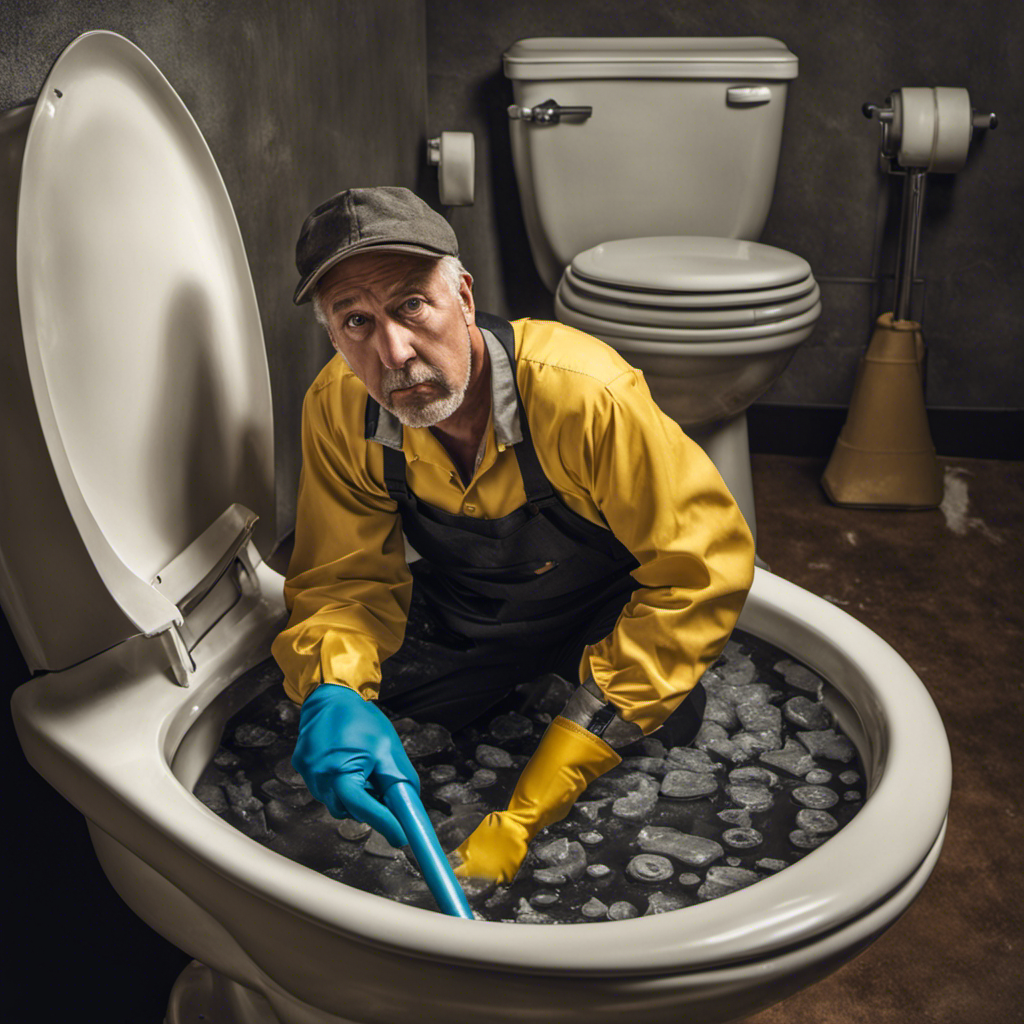Oh no, the dreaded clogged toilet! We’ve all been there, desperately trying to figure out what to do next. But fear not, because I’m here to guide you through the step-by-step process of unclogging your toilet.
From assessing the severity of the clog to using a plunger or even a toilet auger, I’ll show you exactly what to do.
So grab your tools and let’s get to work, because together we can conquer this plumbing disaster!
Key Takeaways
- Assess the severity of the clog to determine the appropriate troubleshooting techniques.
- Gather necessary tools and materials such as a plunger, bucket, wrench, and gloves.
- Use proper plunger technique by creating a seal and pumping vigorously to dislodge the clog.
- If DIY methods fail, consider alternative unclogging methods or contact a professional plumber.
Assess the Severity of the Clog
Before attempting any unclogging methods, it’s important to assess how severe the clog is. Assessing the severity of the clog will help determine the appropriate troubleshooting techniques to use.
The first step is to visually inspect the toilet bowl. Look for signs of water backup or any visible blockage. If the water level is high and not draining, the clog is likely severe.
Next, try flushing the toilet. If the water rises to the brim or overflows, the clog is definitely severe.
Another way to assess severity is by using a plunger. If the plunger doesn’t create any suction or if it’s difficult to push down, the clog is probably severe.
Understanding the severity of the clog will guide you in choosing the most effective troubleshooting techniques.
Gather Necessary Tools and Materials
When it comes to unclogging a toilet, having the right tools and knowing the proper techniques are essential.
In this discussion, I will cover the key points of plunger essentials and technique, alternative unclogging methods, and safety precautions when unclogging.
Plunger Essentials and Technique
To unclog a toilet, start by positioning the plunger securely over the drain. Plunger maintenance is essential to ensure its effectiveness in unclogging toilets. Before using the plunger, make sure it is clean and free from any debris. To do this, rinse it with warm water and a mild detergent. Also, check the rubber suction cup for any cracks or tears, as this can affect its suction power.
If the plunger is in good condition, proceed with the following technique. Push the plunger down gently, creating a seal around the drain. Then, vigorously pump the plunger up and down, maintaining the seal to create pressure and dislodge the clog.
If you don’t have a plunger, you can try using a mixture of hot water and dish soap or a plumbing snake to unclog the toilet.
Alternative Unclogging Methods
One option for unclogging the toilet without a plunger is using a mixture of hot water and dish soap. This method is effective and can be done easily with items you probably already have at home. Here’s how to do it:
- Start by boiling a pot of water on the stove.
- While the water is heating up, add a generous amount of dish soap to the toilet bowl.
- Carefully pour the hot water into the toilet bowl, aiming for the center.
- Let the mixture sit for a few minutes, allowing the hot water and dish soap to break down the clog.
- Flush the toilet to see if the clog has cleared. If not, you may need to repeat the process or try another method.
Using hot water and dish soap is a simple and effective DIY method for unclogging a toilet. However, it’s important to take safety precautions when dealing with clogs.
Safety Precautions When Unclogging
Using hot water and dish soap to unclog a toilet can be a safe and effective method if done correctly. When attempting this method, it is important to follow some safety precautions to avoid any mishaps. Here are some key points to keep in mind:
-
Safety Precautions:
-
Wear gloves to protect your hands from any harmful bacteria.
-
Use a plunger to remove any excess water before attempting the hot water and dish soap method.
-
Common Mistakes:
-
Pouring boiling water directly into the toilet bowl can cause the porcelain to crack. Instead, use hot water that is just below boiling temperature.
-
Using too much dish soap can create excessive foam, making it difficult for the clog to dissolve. Use a small amount, about one tablespoon, and let it sit for a few minutes before flushing.
Attempt to Unclog Using a Plunger
When it comes to unclogging a toilet, using a plunger is often the first step. In this discussion, I will provide you with some useful plunger technique tips that will help you effectively unclog your toilet.
Additionally, I will explore alternative unclogging methods that you can try if the plunger doesn’t work, as well as when it’s time to call in a professional for assistance.
Plunger Technique Tips
To unclog a toilet, it’s important to remember these plunger technique tips. Here’s how you can effectively use a plunger to unclog your toilet:
- Start by positioning the plunger over the drain hole in the toilet bowl.
- Make sure the plunger is submerged in water, creating a tight seal around the drain.
- Push down firmly on the plunger and then pull up quickly, creating suction and pressure to dislodge the clog.
- Repeat this plunging motion several times, increasing the force each time.
If the clog doesn’t clear, try using a plunger alternative such as a toilet auger or a drain snake.
Alternatively, you can try unclogging without tools by using a mixture of hot water and dish soap or a combination of baking soda and vinegar.
Remember to always use caution when attempting to unclog a toilet and consider calling a professional plumber if the clog persists.
Alternative Unclogging Methods
If the plunger doesn’t work, you can try using a mixture of hot water and dish soap or a combination of baking soda and vinegar as alternative unclogging methods.
These methods can help clear stubborn toilet clogs and prevent future ones from occurring.
To use the hot water and dish soap method, start by boiling a kettle or pot of water. Carefully pour the hot water into the toilet bowl, followed by a few squirts of dish soap. Let the mixture sit for a few minutes, then flush the toilet to see if the clog has cleared.
If not, you can try the baking soda and vinegar method. First, pour a cup of baking soda into the toilet bowl. Then, slowly pour a cup of vinegar into the bowl. Let the mixture sit for about 30 minutes, then flush the toilet.
If these methods don’t work, it may be time to call a professional plumber to fix the clog.
When to Call Professional
If you’ve exhausted all other unclogging methods without success, it might be time to call a professional plumber. While there are many instances where you can handle a clogged toilet on your own, there are certain signs that indicate a more serious clog that requires professional assistance.
Here are some signs to look out for:
-
Multiple fixtures clogging simultaneously:
-
This can indicate a blockage in the main sewer line.
-
DIY methods may not be effective in resolving this issue.
-
Persistent clogs despite attempts to unclog:
-
If you’ve tried various methods and the clog keeps coming back, it’s time to call a professional.
-
This could be a sign of a deeper problem, such as a damaged or collapsed sewer pipe.
Use a Toilet Auger for Stubborn Clogs
Using a toilet auger can help you tackle stubborn clogs in your toilet.
A toilet auger, also known as a plumbing snake, is a tool specifically designed for clearing clogs in toilets. It has a long, flexible cable with a coiled end that helps grab and break apart obstructions in the pipe.
The benefits of using a toilet auger are numerous. Firstly, it is more effective than a plunger when it comes to clearing tough clogs. The auger’s cable can reach deeper into the pipes, ensuring that the clog is fully removed.
Additionally, a toilet auger is less likely to cause damage to the toilet compared to a plunger, which can sometimes create suction that leads to leaks or cracks.
If a plunger fails to clear the clog, it is time to try a natural or chemical clog remover to further dissolve the obstruction and restore proper flow.
Try a Natural or Chemical Clog Remover
To tackle a stubborn clog, try using a natural or chemical clog remover. Here are two options to consider:
-
Natural Clog Removers:
-
Baking Soda and Vinegar: Start by pouring half a cup of baking soda down the drain, followed by half a cup of vinegar. Let it sit for about 30 minutes and then flush it with hot water. The combination of baking soda and vinegar helps break down the clog naturally.
-
Enzyme Drain Cleaners: These eco-friendly options use enzymes to eat away at organic matter in the clog. Simply pour the recommended amount of enzyme drain cleaner down the drain, let it sit overnight, and flush with hot water in the morning.
-
Chemical Clog Removers:
-
Caustic Drain Cleaners: These powerful chemicals work by dissolving the clog. Follow the instructions on the product carefully, wear protective gloves, and ensure proper ventilation while using these cleaners.
-
Acidic Drain Cleaners: Acidic drain cleaners are effective against tough clogs, but they can be quite harsh on pipes and should be used with caution. Always follow the instructions and take necessary safety precautions.
Contact a Professional Plumber if All Else Fails
When everything else has been tried, don’t hesitate to reach out to a professional plumber for assistance with your clogged toilet.
While DIY methods can be effective in many cases, there are instances where the expertise of a plumber is necessary.
One key aspect to consider when deciding between a plumber and DIY is the cost. While hiring a plumber may seem more expensive upfront, it can save you money in the long run.
DIY methods can be time-consuming and may not fully resolve the issue, leading to recurring clogs and additional expenses.
Professional plumbers have the knowledge and experience to accurately diagnose and fix the problem, ensuring a lasting solution. Additionally, they have access to specialized tools that may not be available to the average homeowner.
Frequently Asked Questions
How Do I Know if the Clog Is Severe Enough to Require Professional Help?
If the clog is severe, indicators such as water rising to the brim, gurgling sounds, or multiple failed attempts to unclog warrant professional help. Don’t hesitate to call a plumber for a clogged toilet.
Can I Use Any Plunger or Are There Specific Types for Unclogging Toilets?
I can use any plunger to unclog a toilet, but there are specific types designed for this purpose. If I don’t have a plunger, I can try using alternative methods like a toilet auger or a drain snake.
What Are Some Natural Clog Remover Options I Can Try Before Resorting to Chemical Solutions?
To unclog a toilet naturally, there are a few options to try before resorting to chemicals. Some tips include using a plunger, pouring hot water down the drain, or using a mixture of baking soda and vinegar. Additionally, regular maintenance can help prevent clogs.
Are There Any Specific Safety Precautions I Should Take When Using a Toilet Auger?
Toilet auger safety precautions are crucial when using this tool. Knowing how to use a toilet auger properly ensures effectiveness and prevents damage. Follow these step-by-step instructions to safely unclog your toilet.
What Are Some Signs That Indicate the Clog May Be Beyond My Ability to Unclog?
If I encounter signs of a severe clog, such as water backing up or persistent blockage, it may be time to call a plumber. They have the expertise and tools to address more complex toilet clogs.
Conclusion
In conclusion, dealing with a clogged toilet can be a messy and frustrating experience. However, by following the steps outlined in this guide, you can effectively tackle the problem on your own.
Remember, don’t be flushed with panic! Take a deep breath and approach the situation with confidence. With the right tools and techniques, you can overcome any clog that comes your way.
So, roll up your sleeves and get ready to plunge into action!










